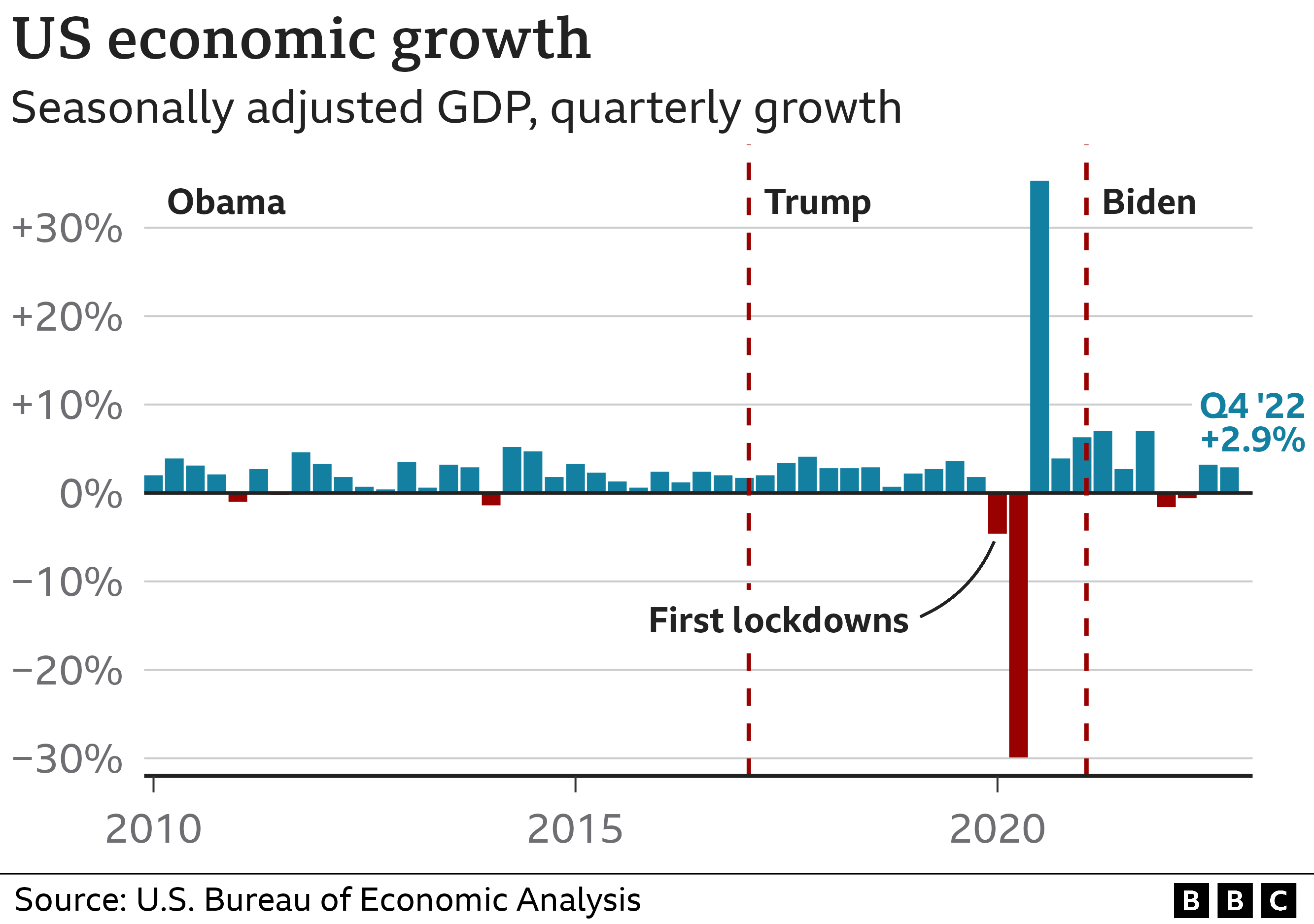Economic Data And The Trump Administration: A Comparative Analysis

Table of Contents
GDP Growth Under the Trump Administration
Comparison to Previous Administrations
Analyzing GDP growth rates provides a crucial benchmark for evaluating economic performance. Let's compare the Trump administration's performance to its predecessors:
- Clinton Administration (1993-2001): Experienced an average annual GDP growth of approximately 4.0%, fueled by technological advancements and robust consumer spending. [Source: Bureau of Economic Analysis (BEA)]
- Bush Administration (2001-2009): Saw an average annual GDP growth of around 2.0%, punctuated by the 2001 recession and the 2008 financial crisis. [Source: BEA]
- Obama Administration (2009-2017): Recovered from the Great Recession, achieving an average annual GDP growth rate of approximately 1.5%. [Source: BEA]
- Trump Administration (2017-2021): Initially experienced strong growth, averaging around 2.5% annually before the COVID-19 pandemic significantly impacted the economy. [Source: BEA]
These figures illustrate that while the Trump administration saw respectable growth, it wasn't significantly higher than previous periods, especially considering the initial economic conditions. External factors, such as global economic conditions and technological advancements, must be considered for a complete analysis.
Impact of Tax Cuts
The 2017 Tax Cuts and Jobs Act, a cornerstone of Trump's economic policy, significantly lowered corporate and individual income tax rates. Proponents argued this would stimulate investment and boost economic growth. Let's look at the data:
- Corporate Tax Rate: Reduced from 35% to 21%, the largest corporate tax cut in decades.
- Individual Tax Rates: Also saw reductions, although the impact varied across income brackets.
While the economy experienced growth following the tax cuts, determining the direct causal link remains challenging. Critics point to other factors, such as already-existing economic momentum and increased government spending, potentially contributing to the observed economic growth. Furthermore, the increased national debt, a consequence of the tax cuts, must be factored into a comprehensive assessment.
Job Creation and Unemployment Rates
Employment Trends During the Trump Presidency
Analyzing job creation and unemployment rates provides insight into the labor market's health under the Trump administration. The Bureau of Labor Statistics (BLS) provides valuable data:
- Unemployment Rate: The unemployment rate fell to a 50-year low during the Trump administration, before the pandemic. [Source: BLS]
- Job Creation: Significant job growth was recorded during the initial years, albeit at a slower pace than during periods of rapid economic expansion in past administrations. [Source: BLS]
- Wage Growth: While job creation was positive, wage growth remained relatively modest for many workers, leading to discussions of income inequality. [Source: BLS]
Analyzing the types of jobs created is equally important. Were these primarily high-skilled, high-paying jobs, or lower-skilled positions? This nuance is crucial for understanding the long-term implications for the workforce.
Comparison to Preceding Administrations
Comparing job creation and unemployment trends under Trump to previous administrations reveals important insights. Visualizing this data through charts and graphs enables easy comparison and highlights any significant discrepancies. For instance, the Obama administration inherited an economy in crisis, and job creation metrics initially reflect this recovery phase. The Bush administration faced different economic challenges, including the dot-com bubble burst and the 9/11 terrorist attacks. Comparing these data points provides context for interpreting the Trump administration's performance.
National Debt and Deficit
Analysis of National Debt Growth
The national debt significantly increased during the Trump administration, fueled by a combination of tax cuts and increased government spending.
- Debt Increase: The national debt grew substantially during his term. [Source: Congressional Budget Office (CBO)]
- Comparison to Previous Administrations: While previous administrations also saw debt increases, the rate of growth under Trump was noteworthy. [Source: CBO]
Understanding the context of this debt increase is crucial. Factors such as economic growth and interest rates influence the debt's sustainability.
Impact of Fiscal Policy
The Trump administration's fiscal policy, characterized by tax cuts and increased spending, directly contributed to the rising national debt. This raises questions about long-term fiscal sustainability and the potential impact on future economic growth. The debate around the appropriate level of government debt is complex and involves diverse economic perspectives.
Trade Policies and Their Economic Impact
Trade Wars and Their Effects
The Trump administration pursued protectionist trade policies, imposing tariffs on goods from various countries, leading to what were commonly called "trade wars."
- Impact on Specific Industries: Industries such as agriculture and manufacturing experienced both benefits and negative consequences. Some sectors benefited from increased domestic demand, while others faced retaliatory tariffs and decreased export opportunities. [Sources: Industry-specific reports, WTO data]
- Trade Balances: Trade balances shifted during this period, reflecting the impact of tariffs and trade negotiations. [Source: BEA]
Analyzing the net effect of these trade policies remains a subject of ongoing debate among economists.
International Trade Relations
Trump's trade policies significantly strained relationships with major trading partners, leading to uncertainty and disruptions in global supply chains.
- Impact on Global Supply Chains: Tariffs and trade disputes caused disruptions to global supply chains, leading to increased costs and uncertainty for businesses.
- Long-Term Implications: The long-term effects of Trump's trade policies on global trade relationships are still unfolding. The impact on multilateral trade agreements and the future of globalization require further analysis.
Conclusion
This comparative analysis of economic data during the Trump administration reveals a multifaceted economic picture. While the economy experienced notable GDP growth and job creation in certain periods, concerns remain regarding the significant increase in the national debt and the long-term consequences of the administration's trade policies. Understanding these economic trends and their interplay is crucial for informed policymaking and for appreciating the complex legacy of the Trump administration’s economic policies. For a deeper dive into specific economic indicators and their relationship to the Trump administration's policies, explore more detailed reports and analyses focusing on Economic Data and the Trump Administration.

Featured Posts
-
 2025 Ankara Ramazan Iftar Sahur Saatleri 10 Mart Pazartesi
Apr 23, 2025
2025 Ankara Ramazan Iftar Sahur Saatleri 10 Mart Pazartesi
Apr 23, 2025 -
 Pazartesi Okul Tatil Mi Istanbul Un Guencel Durumu
Apr 23, 2025
Pazartesi Okul Tatil Mi Istanbul Un Guencel Durumu
Apr 23, 2025 -
 Chinas Cmocs 581 Million Lumina Gold Acquisition Details And Implications
Apr 23, 2025
Chinas Cmocs 581 Million Lumina Gold Acquisition Details And Implications
Apr 23, 2025 -
 The Ultimate Guide To Deleting Your Online Data
Apr 23, 2025
The Ultimate Guide To Deleting Your Online Data
Apr 23, 2025 -
 The China Factor How Market Shifts Affect Bmw Porsche And Other Automakers
Apr 23, 2025
The China Factor How Market Shifts Affect Bmw Porsche And Other Automakers
Apr 23, 2025
